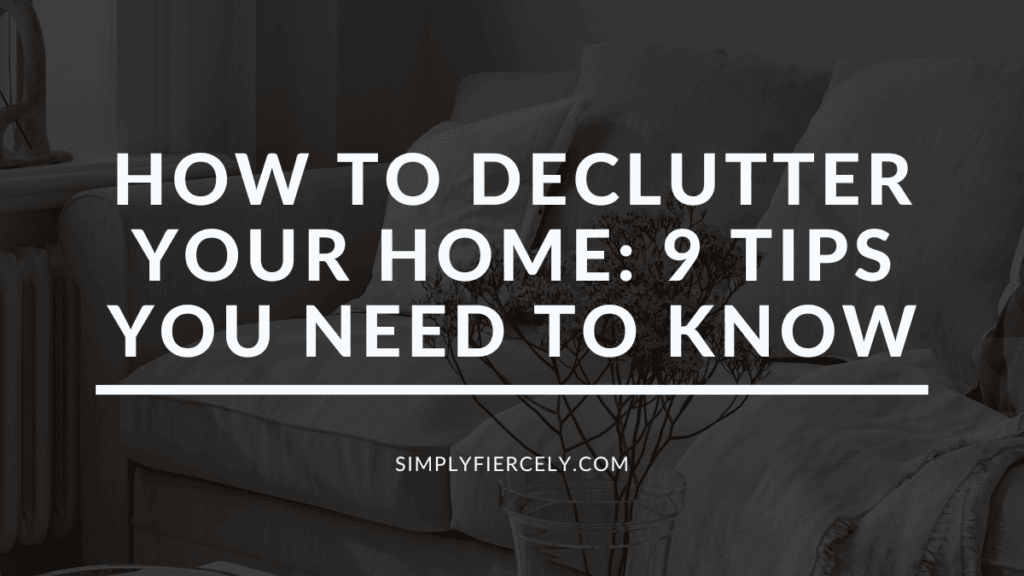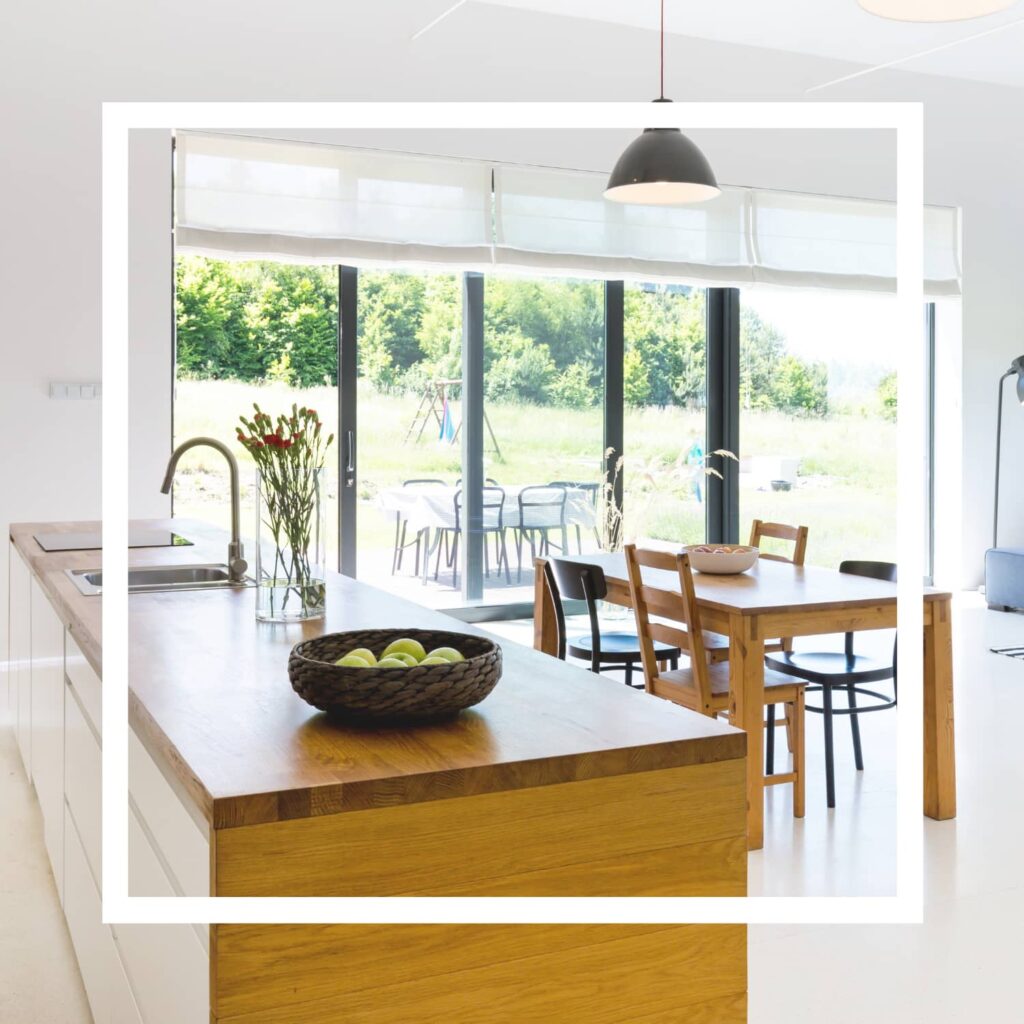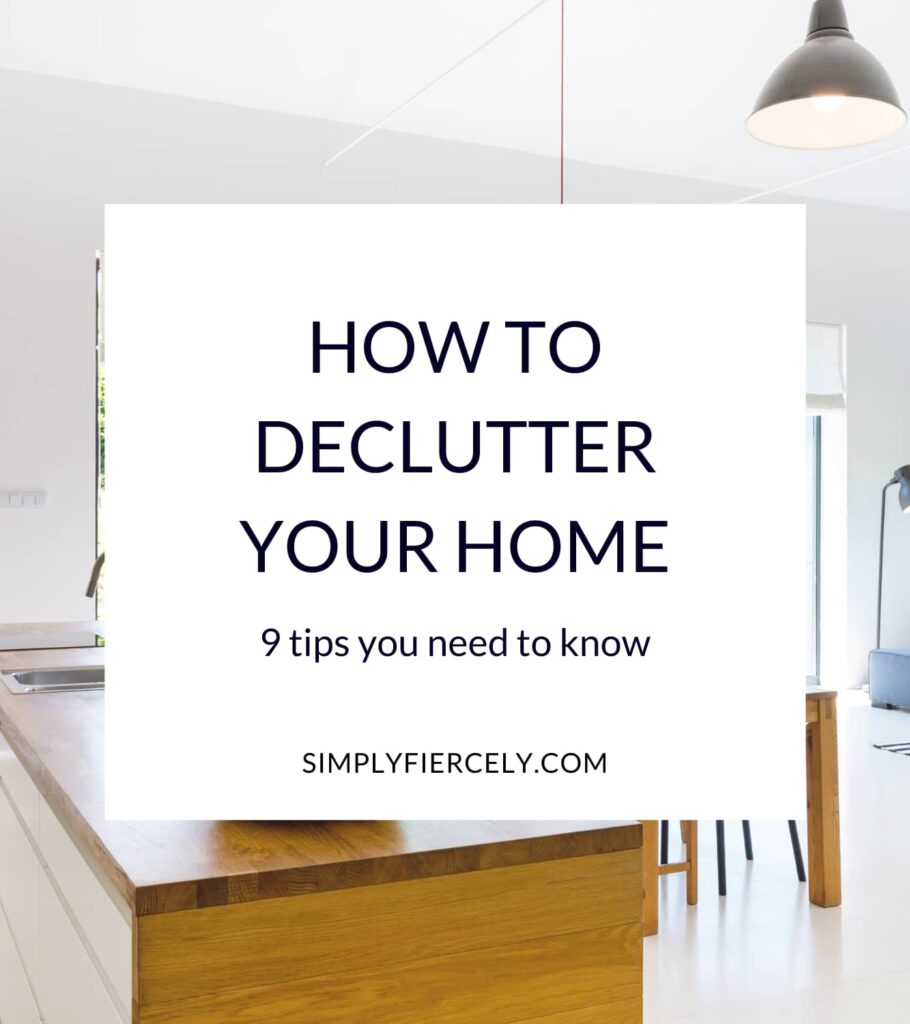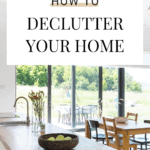Is your house overflowing with more stuff than you can handle? Here are 9 simple tips that will help you declutter your home and create space for life.
Your home should be an oasis—somewhere comforting where you can relax and recharge at the end of the long day. But if you’re like many people, walking through your front door only brings feelings of stress and overwhelm.
The culprit is clutter. When you have more stuff than you need or want, it stops adding value to your life. Instead, it drains you. There’s more to clean, more to worry about, more to trip over. (Trust me, I’ve been there!)
But the good news is it doesn’t have to be that way. You can reclaim your time, money and energy by letting go. Here are 9 proven home decluttering tips that will help you clear your clutter for good.

9 Simple Home Decluttering Tips
1. Start with a meaningful decluttering project
A lot of people feel overwhelmed about where to start decluttering their house. My top tip? Choose a small but meaningful project—something that won’t overwhelm you but will add a lot of value to your life.
For example, if you declutter your bedside table, you’ll get the instant satisfaction of not looking at a mess first thing every morning. Or if you declutter the table by the front door (you know the drop zone I’m talking about!) then you won’t have to stress about finding your keys when you’re in a hurry.
I like to start with these projects because there’s an instant improvement to your quality of life. That satisfaction will help you stay motivated to declutter as you tackle bigger projects in your house.
2. Be clear about your goals
Clutter often stems from a lack of clarity. If you don’t know what you want from your home, then it’s hard to set boundaries … and then everything finds a way to creep it!
The solution? Be clear about your goals and the purpose of each space.
Take your bedroom, for example. For me, it’s a place to rest and recharge at the end of the day. That might sound obvious, but when I take time to spell it out, it’s easier to see that things like paperwork or craft supplies don’t belong there.
These simple guidelines make it easier to declutter your home. Instead of feeling overwhelmed about what to keep or toss, you have guidelines to help you make decisions.
Related Post: 4 Thoughtful Questions to Ask When Decluttering
3. Don’t be afraid to write your own rules
Once you know your goals, you can use them to write your own rules and declutter your house with ease. Here are a few examples:
- If it takes us longer than 15 minutes to clean up, we have too many toys.
- I don’t own clothes that are dry clean only.
- I have one shelf for towels and bedding. If it doesn’t all fit, then something has to go.
- No more than 3 decorative items on any flat surface.
These are just some random things that have helped me with decluttering. Your rules might look completely different, and that’s OK! It’s not about what you should do; instead, it’s about what works for you. Write your own rules and then use them to simplify your life.
4. Decide ahead of time what you’ll do with your decluttering
A lot of people get stuck with their decluttering because they don’t know how to dispose of their unwanted goods. I know because I’ve been there —and I’ve got a powerful tip for you.
Decide what you’ll do with your stuff before you start decluttering your house.
Why is this important? Because when you’re decluttering you have a lot of decisions to make and it’s exhausting. You also have to deal with the emotional weight of letting go. It can be really draining, so you want to do everything you can to make the process easier.
By deciding ahead of time what you’ll do with your stuff, you reduce decision fatigue. You’re also less likely to let emotions influence your choices. For example, guilt over wasted money might make you feel like you have to sell your stuff, even if you don’t have the time or energy to do it.
5. Set a timer when decluttering to avoid getting sidetracked
If you’ve ever attempted decluttering before, then you probably know how easy it is to get side-tracked. An old dress reminds you of a friend that you haven’t spoken to in ages, and the next thing you know you’re digging through old photos and getting lost down memory lane.
It happens to us all, which is why I like to use a timer while decluttering. Set yourself a limit (say five minutes) and don’t spend longer than that on any one item.
If you can’t decide what to do with something, put it aside and you can come back to it later. I know—it might feel like double handling—but I think it’s better than getting stuck. Keep going with what feels easy and create momentum. You’ll feel good about making progress, and this will empower you when you come back and deal with the sticky stuff.

6. Question the clutter stories that have led you to hold on to things longer than necessary
If there’s one thing I’ve learned from years as a minimalist, it’s that our stuff is never just “stuff”. Instead, the things we own are a reflection of our thoughts and beliefs.
For example, I used to own over a hundred pairs of shoes! Why? Because deep down I felt insecure about my appearance—but when I wore sky-high stilettos, I could fool myself into feeling confident.
Your clutter stories might be completely different, but if you struggle to let go, I can almost guarantee you have them. Spend some time getting to the roots of your clutter and it will help you declutter your home for good.
Related Post: Why Your Life is Busy + Cluttered (Plus What to Do About It)
7. Set realistic expectations for how long decluttering your home might take
Look, I’ve got to be honest. I’m tired of blog posts that claim you can declutter your entire house in a day or a weekend.
It might be possible for some, but I think for most people it sets unrealistic expectations. It took you a long time to bring that clutter into your home and it will probably take a while to get rid of it. Trying to do too much too quickly will only make you feel like a failure, which in turn makes you want to quit.
On the other hand, realistic expectations (based on the time and energy you have available) set you up for success. Plus, slow decluttering gives you time to learn from your clutter so you can make better choices in the future.
Pro Tip: There are some times when you need to get rid of clutter quickly, like when you’re decluttering before a move. Both of these articles have helpful tips!
8. Celebrate small wins and take photos as you declutter your home—it will serve as a reminder of how far you’ve come when times are difficult.
It took me years to declutter my home. YEARS. So trust me, I know that sometimes, it feels like you’re not making any progress. Sometimes you just feel like throwing in the towel and giving up.
When this happens, one of the most powerful things you can do is to reflect on how far you’ve come. Celebrate the progress you’ve made, instead of obsessing about how far you’ve got to go.
One thing that will help you do this is taking photos. You might not feel like you’ve done much but pictures tell the truth! Also, I think decluttering is a process of discovery, and documenting your journey can help you understand the emotional reasons behind why you’ve held on to certain things.
9. Include self-care in your decluttering plan
Decluttering is exhausting. There’s a lot of physical work involved, and it’s mentally draining too. If you’ve ever spent an afternoon decluttering your grandmother’s old quilts or your firstborn’s baby clothes, then you’ll know what I mean. Emotions are raw and it’s hard on the heart.
This is why a lot of people get stuck in a start-stop pattern of decluttering. They try to do too much at once and then get burnt out.
If you can relate, then slow decluttering will help, but it’s also important to plan for self-care. Finish up a half-hour early and then go for a walk in the sunshine or have a quiet cup of coffee on the deck. Or whatever it is that restores you—but make it a priority.
Self-care shouldn’t be an afterthought. Instead, it’s an essential part of decluttering your home. Take care of yourself, so that you can keep going.
10. Bonus tip: download your free decluttering guide
If you enjoyed this post, then I invite you to download my free decluttering guide. You’ll learn the step-by-step process that helped me declutter over 80% of my belongings—plus there’s a troubleshooting guide that will help you deal with tricky clutter like sentimental items.
Resources for Decluttering Your Home
As a shopaholic turned minimalist, I’ve written a lot about decluttering! Here are a few other blog posts that will help you declutter the home:
- 10 Proven Tips For A Clutter-Free Home
- 23 Decluttering Ideas That Will Create Space In Your Home + Life
- What To Do When You’re Overwhelmed By Clutter
- 7 Secrets For A Decluttered Home (That Might Surprise You!)
Have you had success with decluttering your home? What are your top tips for clearing the clutter?



I really began decluttering during the lockdown in Mumbai. 2 years when we had little help and lived on Amazon and Flipkart! I realised how much we had that we didn’t need. We didn’t go anywhere so we didn’t buy clothes. I wore the same 3 tees and yoga pants till they went into holes, then I took out more from the cupboard. We’re still doing that… living off our clothes and not buying more. I gave away clothes that were too big. I threw out shoes that had aged without being worn. I gave away glasses we never used. I gave away china we never used. It goes on. We aren’t being minimalist as yet, just grateful we still have things to choose from that we love. Next item: books!
Beginning decluttering was slow takes time to see how much stuff you really own I’m not over shopping working with a budget I have a ways to go I already feel good about the progress that I made
Great post. Such practical, simple and achievable steps.
I’m so glad you found it helpful Tracey! Thanks for reading 🙂